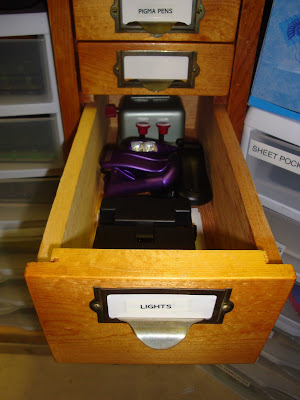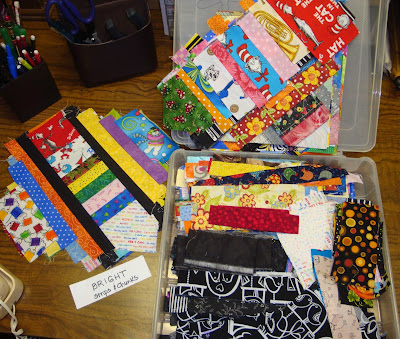This may sound weird, but I think sewing/quilt construction have a lot in common with preparing food. I see patterns as recipes and my stash as ingredients. Maybe my sewing machine is like my mixer or stove...the place where all the ingredients get blended and "cooked" together into a fanciful fabric banquet!
I approach my sewing space and tool storage as I do my cooking area and kitchen gear. I like useful tools, and they need to be handy so that I can lay my hands on them when I need them! There are utensils, pots and appliances that I don't use often when I cook, so those don't occupy the choicest storage spaces in my kitchen. So it goes, as well, in the quilt cave.
I have boasted (and lamented) that my sewing area is in the basement...the quilt cave. It is a shared family space and also has the added excitement of possible flooding due to sump pump failure, extreme heavy rains, or the storm sewer backing up.
We've had a few inches of water down there twice in the 16 years we've lived here. This part of Michigan used to be a swamp with friendly dinosaurs splashing around, and our house basically sits in a hard clay bowl...as a result, we worship our sump pump (in the corner...just beyond the cat).
Therefore, the basement isn't finished and the collection of area rugs that is "patched" together in the traffic areas can be rolled up quickly and dragged upstairs if we notice water sneaking in around the edges down there (if we are home...).
All this house history explains why I set up my sewing area the way I do...it all seems temporary and movable. I would love some built-in fixtures with drawers, work surfaces...a ceiling...but the distant memory of water/moisture removal makes that not likely in this house.
The plastic shelving units that line most of the basement perimeter can get wet...the bottom shelves hold plastic tubs that can tolerate a few inches of water. Some fixtures are up on blocks, bookcases are up off the floor, tables/fixtures either fold up or are garage sale/curbside finds. A dehumidifier is on standby. I'd like to think I am always ready for the next flood.
Our basement is "L-shaped," and everything is set up so that our old TV, on a lazy Susan, can be viewed from anywhere down there (priorities...). Therefore, my sewing space centers around the bend of the "L" and the one metal support column that supports the house I-beam. That pole (and sewer pipe...lovely) would be out in the middle of the floor if I had not set up around it.
If this was a TV reality show, at this point I would say "with all this in mind, DESIGN THIS SPACE!"
I like having my tools readily accessible as I sit in my space and sew, design, quilt, and craft. As Julie Morganstern preaches in Organizing From the Inside Out
Labeled, plastic, drawered storage, both on the floor and on tables helps everything have a home and keep the surfaces from being cluttered.
I found these drawer units
I do label these, and if I need to change labels, I just stick the new one on top of the old one(s).
I used to think I would just memorize where things were, so I wouldn't have to label. Yeah, right.
The drawers are easy to move around, to make sure that the ones I access the most are the fastest and closest to get to.
I like that the drawers also serve as a container that I can remove easily and take to where I am working (as long as I put it back when I am through).
I used to use a sewing box for tools, but the box was hard to store, not easy to access, and didn't hold everything. It was deep, dark, and cavernous...I would have to root around it it for a while to find something just out of reach at the bottom...another silly waste of time.
Having tools easy to access and not lost eliminates re-purchasing tools that can't be found...having a home makes the tool, or drawer, almost fun to put away...and it is a quick and satisfying exercise.
In her book, Julie preaches that if the storage or container is inconvenient or hard to access, it discourages the "equalizing" step...putting things back...this is so important if you are to maintain and enjoy a newly organized space (or have any hope of finding the tool the NEXT time you want to use it).
I place 3 out of 4 of these little-drawered units on top of a treasured family heirloom. This sewing machine cabinet was designed and built by my husband's grandfather, Arthur Joy Rawson, for his wife, Margaret Byrd Rawson. When she asked if I would like it, I jumped up and down like a 4-year-old! It is so charmingly practical!
It used to hold a Necchi sewing machine, so there is an interesting hole where the machine used to sit that I cover with a piece of Plexiglas. At some point I may fill the space with some antique sewing machine attachments.
Arthur designed and built each drawer to Margaret's specifications.
Rather than deeper drawers fitted with short dowels to hold thread, she wanted shallow drawers to store thread on its side so that she could select her spools quickly and easily.
He affixed little pieces of wood to the floor of each thread drawer to keep things from rolling out of place.
I love that he put label hardware on the drawers. I can easily label and relabel things as needed.
I find the shallow drawers very efficient storage space for tools and items that store practically flat. Scrap booking people tell me that pens should be stored flat, so these drawers are perfect for my Pigma pens.
I keep my good scissors separate from my paper and junk scissors.
No digging for things...everything is easily visible.
I don't keep it stored with the quilt I am working on just in case I need that thimble, etc. while working on something else (the hair scrunchy on the spool keeps the loose end under control...it looks kind of silly, but works).

This really deep drawer has a removable divider. Margaret told me that Arthur designed it to store commercial clothing patterns (without the divider) or taller items. I store large zippered project bags in there.
The center top drawer fit around the base of the sewing machine...I love how he designed this!
The cabinet has a knee bar and built-in foot pedal holder, which I temporarily removed so that I could add some storage underneath. As lovely as it is for storage, the dimensions of the small work surface are impractical for piecing quilts using a sewing machine installed in this cabinet.
I store two 3-drawer plastic storage units
Small square rulers.
Larger square rulers.
Specialty rulers like my Pineapple Rule, Companion Angle, Easy Angles, Tri Recs, etc. store easily. Instructions that came with the rulers are in the bottom of each draw, under the rulers, so that I don't have to go searching when I need help.

To the right of Arthur's cabinet, my square, brown, wooden table is the base of my work area. I bought that table for $15 from a used restaurant supply store 20 years ago when I lived in Galveston, TX. I've really gotten my money's worth out of it!
It is really heavy and sturdy (the legs are solid wood, 4" x 4"), so I don't think twice about stacking other second-hand fixtures on top of it for additional storage. I found the brown shelf and white cubby hole cabinets for $10 each! A little cleaning and some paint made them a valuable part of my storage set up. A fourth set of plastic drawers holds things I don't use regularly.
I keep a few of my favorite movies downstairs and have a CD boom box for listening to books and the radio. With an old TV, DVD player, VCR, and my stash, I could entertain myself for WEEKS down there! (The lack of a quilt cave bathroom is the only snag...)
It is fun combing thrift shops and garage sales for storage fixtures for my set up. It would be fun to make a pretty arrangement, one that might make Martha Stewart take notice, but since I am in the cave I just worry about function and practicality.
I have an odd $5 end table beside the wooden table (and behind the small folding table work surface). This allows me to store my large 15", 16.5" and 20.5" square rotary rulers standing up between things (hiding to the left of the yellow arrow, below). The two big plastic drawers hold quilt hangers and larger quilting odds and ends that I don't need immediate access to. I consider these drawers "catch all" drawers for things I don't know what to do with and that don't really organize very well...odd stuff...if you were looking for my chaos corner...here it is!
Long rulers reside in commercially-available slotted storage racks which joyfully fit in 2 of the cubby holes. Other things stored in this salvaged cubby hole cabinet include:
- spray starches and quilt soaps
- tape dispenser
- freezer paper on a roll
- a roll of narrow paper (for designing applique borders)
- a duster
- a back scratcher (big grin)
- a stack of index cards, always at the ready for renaming a bin or inserting in a project/UFO box
- lint rollers (to remove the cat from projects)
- an old vitamin bottle for discarded needles and pins
- some containers of pruned scrappy squares
- a few handy tools
- my magnet wand for picking up lost pins/needles.
I have more drawered storage under the wooden table, with my bulky light box hiding on the top of them, just under the top of the table.
My batting scraps, large yardage for quilt backs, etc. are stored in the creepy area under the basement stairs (also family costumes).
I store my 3 large folding tables against these bins until I need more work space or friends are over to sew (BIG grin).
I store my rolls of fusible web and interfacing, large quilting templates, paper, etc. in tubs on top of the "wall of stash". They are light enough that the larger tubs, stored up high, aren't too difficult to access.
My new Jenome 6600 has this excellent raised work table. I am able to store my machine accessory box right underneath, and it has enough room to hold a dozen bobbins, filled or empty.
Due to the cat, my pincushion is not convenient...if it is convenient for me, it is TOO convenient for him. My buddy Ola made me this little "needle minder" which makes grabbing a needle quickly REALLY easy to do. I use it both at home and on the road.
My pressing table is a tray table that I got a great deal on because it was scratched. My June Taylor pressing board fits well on it.
My 14" x 14" Art Bin containers fit on my salvaged, mismatched shelves ONLY because the basement is unfinished and they just fit between the wall studs. See? Not so glamorous.
I guess if I were to install wider shelves I could drywall this one little wall, but as long as the bins are in place, no one can see how ugly the wall really is. This stairwell wall is the only non-concrete wall in the whole basement. I share that space with my daughter's computer table...for now (evil grin).
The only place for a design wall down here is at the bottom of the steps...I really need to replace this pink blanket (left over from college, believe it or not) with something decent.
In stitches,
Teresa :o)



































































































